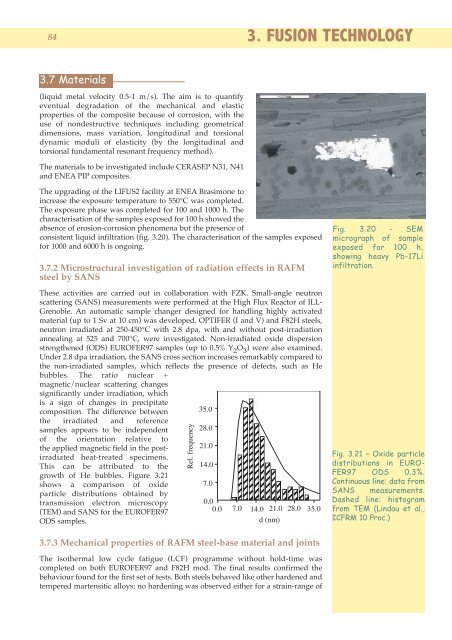1. magnetic confinement - ENEA - Fusione
1. magnetic confinement - ENEA - Fusione
1. magnetic confinement - ENEA - Fusione
You also want an ePaper? Increase the reach of your titles
YUMPU automatically turns print PDFs into web optimized ePapers that Google loves.
84<br />
3. FUSION TECHNOLOGY<br />
3.7 Materials<br />
(liquid metal velocity 0.5-1 m/s). The aim is to quantify<br />
eventual degradation of the mechanical and elastic<br />
properties of the composite because of corrosion, with the<br />
use of nondestructive techniques including geometrical<br />
dimensions, mass variation, longitudinal and torsional<br />
dynamic moduli of elasticity (by the longitudinal and<br />
torsional fundamental resonant frequency method).<br />
The materials to be investigated include CERASEP N31, N41<br />
and <strong>ENEA</strong> PIP composites.<br />
The upgrading of the LIFUS2 facility at <strong>ENEA</strong> Brasimone to<br />
increase the exposure temperature to 550°C was completed.<br />
The exposure phase was completed for 100 and 1000 h. The<br />
characterisation of the samples exposed for 100 h showed the<br />
absence of erosion-corrosion phenomena but the presence of<br />
consistent liquid infiltration (fig. 3.20). The characterisation of the samples exposed<br />
for 1000 and 6000 h is ongoing.<br />
3.7.2 Microstructural investigation of radiation effects in RAFM<br />
steel by SANS<br />
These activities are carried out in collaboration with FZK. Small-angle neutron<br />
scattering (SANS) measurements were performed at the High Flux Reactor of ILL-<br />
Grenoble. An automatic sample changer designed for handling highly activated<br />
material (up to 1 Sv at 10 cm) was developed. OPTIFER (I and V) and F82H steels,<br />
neutron irradiated at 250-450°C with 2.8 dpa, with and without post-irradiation<br />
annealing at 525 and 700°C, were investigated. Non-irradiated oxide dispersion<br />
strengthened (ODS) EUROFER97 samples (up to 0.5% Y 2 O 3 ) were also examined.<br />
Under 2.8 dpa irradiation, the SANS cross section increases remarkably compared to<br />
the non-irradiated samples, which reflects the presence of defects, such as He<br />
bubbles. The ratio nuclear +<br />
<strong>magnetic</strong>/nuclear scattering changes<br />
significantly under irradiation, which<br />
is a sign of changes in precipitate<br />
composition. The difference between<br />
the irradiated and reference<br />
samples appears to be independent<br />
of the orientation relative to<br />
the applied <strong>magnetic</strong> field in the postirradiated<br />
35.0<br />
28.0<br />
2<strong>1.</strong>0<br />
heat-treated specimens.<br />
This can be attributed to the 14.0<br />
growth of He bubbles. Figure 3.21<br />
shows a comparison of oxide 7.0<br />
particle distributions obtained by<br />
transmission electron microscopy 0.0<br />
(TEM) and SANS for the EUROFER97<br />
0.0 7.0 14.0 2<strong>1.</strong>0 28.0 35.0<br />
ODS samples.<br />
d (nm)<br />
Rel. frequency<br />
Fig. 3.20 - SEM<br />
micrograph of sample<br />
exposed for 100 h,<br />
showing heavy Pb-17Li<br />
infiltration.<br />
Fig. 3.21 – Oxide particle<br />
distributions in EURO-<br />
FER97 ODS 0.3%.<br />
Continuous line: data from<br />
SANS measurements.<br />
Dashed line: histogram<br />
from TEM (Lindau et al.,<br />
ICFRM 10 Proc.)<br />
3.7.3 Mechanical properties of RAFM steel-base material and joints<br />
The isothermal low cycle fatigue (LCF) programme without hold-time was<br />
completed on both EUROFER97 and F82H mod. The final results confirmed the<br />
behaviour found for the first set of tests. Both steels behaved like other hardened and<br />
tempered martensitic alloys: no hardening was observed either for a strain-range of













